Merge, join, concatenate and compare#
pandas provides various methods for combining and comparing Series or
DataFrame.
concat(): Merge multipleSeriesorDataFrameobjects along a shared index or columnDataFrame.join(): Merge multipleDataFrameobjects along the columnsDataFrame.combine_first(): Update missing values with non-missing values in the same locationmerge(): Combine twoSeriesorDataFrameobjects with SQL-style joiningmerge_ordered(): Combine twoSeriesorDataFrameobjects along an ordered axismerge_asof(): Combine twoSeriesorDataFrameobjects by near instead of exact matching keysSeries.compare()andDataFrame.compare(): Show differences in values between twoSeriesorDataFrameobjects
concat()#
The concat() function concatenates an arbitrary amount of
Series or DataFrame objects along an axis while
performing optional set logic (union or intersection) of the indexes on
the other axes. Like numpy.concatenate, concat()
takes a list or dict of homogeneously-typed objects and concatenates them.
In [1]: df1 = pd.DataFrame(
...: {
...: "A": ["A0", "A1", "A2", "A3"],
...: "B": ["B0", "B1", "B2", "B3"],
...: "C": ["C0", "C1", "C2", "C3"],
...: "D": ["D0", "D1", "D2", "D3"],
...: },
...: index=[0, 1, 2, 3],
...: )
...:
In [2]: df2 = pd.DataFrame(
...: {
...: "A": ["A4", "A5", "A6", "A7"],
...: "B": ["B4", "B5", "B6", "B7"],
...: "C": ["C4", "C5", "C6", "C7"],
...: "D": ["D4", "D5", "D6", "D7"],
...: },
...: index=[4, 5, 6, 7],
...: )
...:
In [3]: df3 = pd.DataFrame(
...: {
...: "A": ["A8", "A9", "A10", "A11"],
...: "B": ["B8", "B9", "B10", "B11"],
...: "C": ["C8", "C9", "C10", "C11"],
...: "D": ["D8", "D9", "D10", "D11"],
...: },
...: index=[8, 9, 10, 11],
...: )
...:
In [4]: frames = [df1, df2, df3]
In [5]: result = pd.concat(frames)
In [6]: result
Out[6]:
A B C D
0 A0 B0 C0 D0
1 A1 B1 C1 D1
2 A2 B2 C2 D2
3 A3 B3 C3 D3
4 A4 B4 C4 D4
5 A5 B5 C5 D5
6 A6 B6 C6 D6
7 A7 B7 C7 D7
8 A8 B8 C8 D8
9 A9 B9 C9 D9
10 A10 B10 C10 D10
11 A11 B11 C11 D11
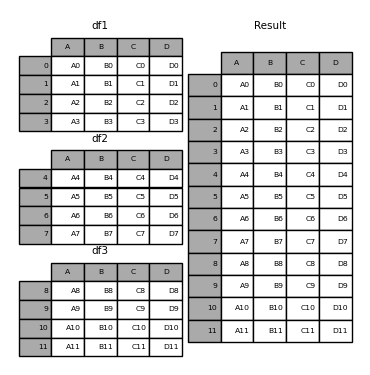
Note
concat() makes a full copy of the data, and iteratively
reusing concat() can create unnecessary copies. Collect all
DataFrame or Series objects in a list before using
concat().
frames = [process_your_file(f) for f in files]
result = pd.concat(frames)
Note
When concatenating DataFrame with named axes, pandas will attempt to preserve
these index/column names whenever possible. In the case where all inputs share a
common name, this name will be assigned to the result. When the input names do
not all agree, the result will be unnamed. The same is true for MultiIndex,
but the logic is applied separately on a level-by-level basis.
Joining logic of the resulting axis#
The join keyword specifies how to handle axis values that don’t exist in the first
DataFrame.
join='outer' takes the union of all axis values
In [7]: df4 = pd.DataFrame(
...: {
...: "B": ["B2", "B3", "B6", "B7"],
...: "D": ["D2", "D3", "D6", "D7"],
...: "F": ["F2", "F3", "F6", "F7"],
...: },
...: index=[2, 3, 6, 7],
...: )
...:
In [8]: result = pd.concat([df1, df4], axis=1)
In [9]: result
Out[9]:
A B C D B D F
0 A0 B0 C0 D0 NaN NaN NaN
1 A1 B1 C1 D1 NaN NaN NaN
2 A2 B2 C2 D2 B2 D2 F2
3 A3 B3 C3 D3 B3 D3 F3
6 NaN NaN NaN NaN B6 D6 F6
7 NaN NaN NaN NaN B7 D7 F7

join='inner' takes the intersection of the axis values
In [10]: result = pd.concat([df1, df4], axis=1, join="inner")
In [11]: result
Out[11]:
A B C D B D F
2 A2 B2 C2 D2 B2 D2 F2
3 A3 B3 C3 D3 B3 D3 F3

To perform an effective “left” join using the exact index from the original
DataFrame, result can be reindexed.
In [12]: result = pd.concat([df1, df4], axis=1).reindex(df1.index)
In [13]: result
Out[13]:
A B C D B D F
0 A0 B0 C0 D0 NaN NaN NaN
1 A1 B1 C1 D1 NaN NaN NaN
2 A2 B2 C2 D2 B2 D2 F2
3 A3 B3 C3 D3 B3 D3 F3

Ignoring indexes on the concatenation axis#
For DataFrame objects which don’t have a meaningful index, the ignore_index
ignores overlapping indexes.
In [14]: result = pd.concat([df1, df4], ignore_index=True, sort=False)
In [15]: result
Out[15]:
A B C D F
0 A0 B0 C0 D0 NaN
1 A1 B1 C1 D1 NaN
2 A2 B2 C2 D2 NaN
3 A3 B3 C3 D3 NaN
4 NaN B2 NaN D2 F2
5 NaN B3 NaN D3 F3
6 NaN B6 NaN D6 F6
7 NaN B7 NaN D7 F7
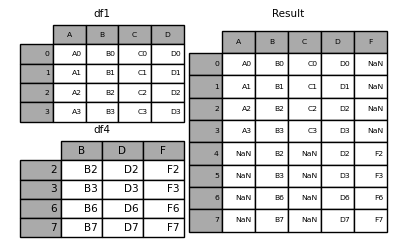
Concatenating Series and DataFrame together#
You can concatenate a mix of Series and DataFrame objects. The
Series will be transformed to DataFrame with the column name as
the name of the Series.
In [16]: s1 = pd.Series(["X0", "X1", "X2", "X3"], name="X")
In [17]: result = pd.concat([df1, s1], axis=1)
In [18]: result
Out[18]:
A B C D X
0 A0 B0 C0 D0 X0
1 A1 B1 C1 D1 X1
2 A2 B2 C2 D2 X2
3 A3 B3 C3 D3 X3

Unnamed Series will be numbered consecutively.
In [19]: s2 = pd.Series(["_0", "_1", "_2", "_3"])
In [20]: result = pd.concat([df1, s2, s2, s2], axis=1)
In [21]: result
Out[21]:
A B C D 0 1 2
0 A0 B0 C0 D0 _0 _0 _0
1 A1 B1 C1 D1 _1 _1 _1
2 A2 B2 C2 D2 _2 _2 _2
3 A3 B3 C3 D3 _3 _3 _3

ignore_index=True will drop all name references.
In [22]: result = pd.concat([df1, s1], axis=1, ignore_index=True)
In [23]: result
Out[23]:
0 1 2 3 4
0 A0 B0 C0 D0 X0
1 A1 B1 C1 D1 X1
2 A2 B2 C2 D2 X2
3 A3 B3 C3 D3 X3

Resulting keys#
The keys argument adds another axis level to the resulting index or column (creating
a MultiIndex) associate specific keys with each original DataFrame.
In [24]: result = pd.concat(frames, keys=["x", "y", "z"])
In [25]: result
Out[25]:
A B C D
x 0 A0 B0 C0 D0
1 A1 B1 C1 D1
2 A2 B2 C2 D2
3 A3 B3 C3 D3
y 4 A4 B4 C4 D4
5 A5 B5 C5 D5
6 A6 B6 C6 D6
7 A7 B7 C7 D7
z 8 A8 B8 C8 D8
9 A9 B9 C9 D9
10 A10 B10 C10 D10
11 A11 B11 C11 D11
In [26]: result.loc["y"]
Out[26]:
A B C D
4 A4 B4 C4 D4
5 A5 B5 C5 D5
6 A6 B6 C6 D6
7 A7 B7 C7 D7
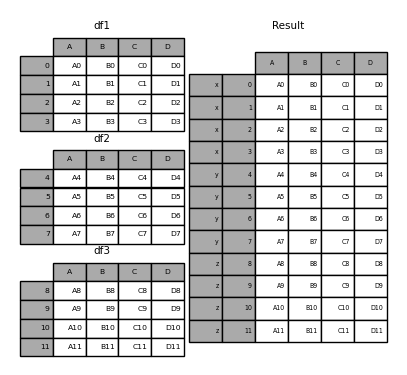
The keys argument cane override the column names
when creating a new DataFrame based on existing Series.
In [27]: s3 = pd.Series([0, 1, 2, 3], name="foo")
In [28]: s4 = pd.Series([0, 1, 2, 3])
In [29]: s5 = pd.Series([0, 1, 4, 5])
In [30]: pd.concat([s3, s4, s5], axis=1)
Out[30]:
foo 0 1
0 0 0 0
1 1 1 1
2 2 2 4
3 3 3 5
In [31]: pd.concat([s3, s4, s5], axis=1, keys=["red", "blue", "yellow"])
Out[31]:
red blue yellow
0 0 0 0
1 1 1 1
2 2 2 4
3 3 3 5
You can also pass a dict to concat() in which case the dict keys will be used
for the keys argument unless other keys argument is specified:
In [32]: pieces = {"x": df1, "y": df2, "z": df3}
In [33]: result = pd.concat(pieces)
In [34]: result
Out[34]:
A B C D
x 0 A0 B0 C0 D0
1 A1 B1 C1 D1
2 A2 B2 C2 D2
3 A3 B3 C3 D3
y 4 A4 B4 C4 D4
5 A5 B5 C5 D5
6 A6 B6 C6 D6
7 A7 B7 C7 D7
z 8 A8 B8 C8 D8
9 A9 B9 C9 D9
10 A10 B10 C10 D10
11 A11 B11 C11 D11
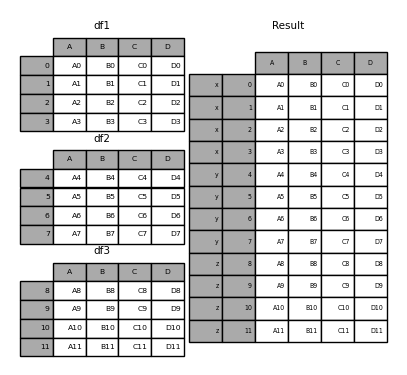
In [35]: result = pd.concat(pieces, keys=["z", "y"])
In [36]: result
Out[36]:
A B C D
z 8 A8 B8 C8 D8
9 A9 B9 C9 D9
10 A10 B10 C10 D10
11 A11 B11 C11 D11
y 4 A4 B4 C4 D4
5 A5 B5 C5 D5
6 A6 B6 C6 D6
7 A7 B7 C7 D7
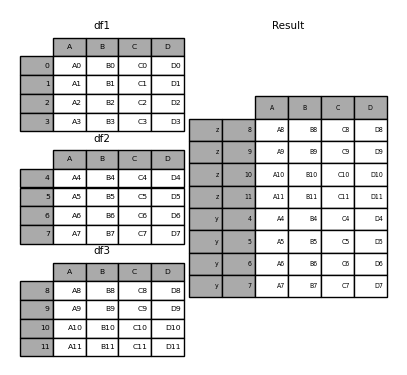
The MultiIndex created has levels that are constructed from the passed keys and
the index of the DataFrame pieces:
In [37]: result.index.levels
Out[37]: FrozenList([['z', 'y'], [4, 5, 6, 7, 8, 9, 10, 11]])
levels argument allows specifying resulting levels associated with the keys
In [38]: result = pd.concat(
....: pieces, keys=["x", "y", "z"], levels=[["z", "y", "x", "w"]], names=["group_key"]
....: )
....:
In [39]: result
Out[39]:
A B C D
group_key
x 0 A0 B0 C0 D0
1 A1 B1 C1 D1
2 A2 B2 C2 D2
3 A3 B3 C3 D3
y 4 A4 B4 C4 D4
5 A5 B5 C5 D5
6 A6 B6 C6 D6
7 A7 B7 C7 D7
z 8 A8 B8 C8 D8
9 A9 B9 C9 D9
10 A10 B10 C10 D10
11 A11 B11 C11 D11
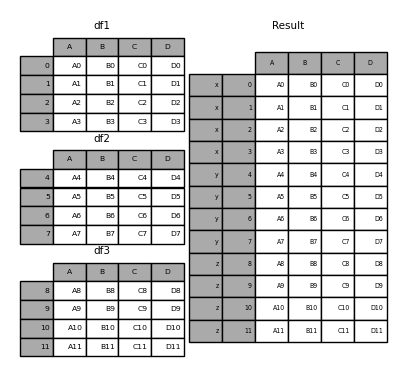
In [40]: result.index.levels
Out[40]: FrozenList([['z', 'y', 'x', 'w'], [0, 1, 2, 3, 4, 5, 6, 7, 8, 9, 10, 11]])
Appending rows to a DataFrame#
If you have a Series that you want to append as a single row to a DataFrame, you can convert the row into a
DataFrame and use concat()
In [41]: s2 = pd.Series(["X0", "X1", "X2", "X3"], index=["A", "B", "C", "D"])
In [42]: result = pd.concat([df1, s2.to_frame().T], ignore_index=True)
In [43]: result
Out[43]:
A B C D
0 A0 B0 C0 D0
1 A1 B1 C1 D1
2 A2 B2 C2 D2
3 A3 B3 C3 D3
4 X0 X1 X2 X3
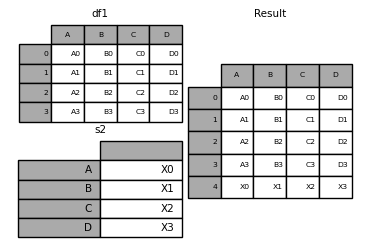
merge()#
merge() performs join operations similar to relational databases like SQL.
Users who are familiar with SQL but new to pandas can reference a
comparison with SQL.
Merge types#
merge() implements common SQL style joining operations.
one-to-one: joining two
DataFrameobjects on their indexes which must contain unique values.many-to-one: joining a unique index to one or more columns in a different
DataFrame.many-to-many : joining columns on columns.
Note
When joining columns on columns, potentially a many-to-many join, any
indexes on the passed DataFrame objects will be discarded.
For a many-to-many join, if a key combination appears
more than once in both tables, the DataFrame will have the Cartesian
product of the associated data.
In [44]: left = pd.DataFrame(
....: {
....: "key": ["K0", "K1", "K2", "K3"],
....: "A": ["A0", "A1", "A2", "A3"],
....: "B": ["B0", "B1", "B2", "B3"],
....: }
....: )
....:
In [45]: right = pd.DataFrame(
....: {
....: "key": ["K0", "K1", "K2", "K3"],
....: "C": ["C0", "C1", "C2", "C3"],
....: "D": ["D0", "D1", "D2", "D3"],
....: }
....: )
....:
In [46]: result = pd.merge(left, right, on="key")
In [47]: result
Out[47]:
key A B C D
0 K0 A0 B0 C0 D0
1 K1 A1 B1 C1 D1
2 K2 A2 B2 C2 D2
3 K3 A3 B3 C3 D3

The how argument to merge() specifies which keys are
included in the resulting table. If a key combination does not appear in
either the left or right tables, the values in the joined table will be
NA. Here is a summary of the how options and their SQL equivalent names:
Merge method |
SQL Join Name |
Description |
|---|---|---|
|
|
Use keys from left frame only |
|
|
Use keys from right frame only |
|
|
Use union of keys from both frames |
|
|
Use intersection of keys from both frames |
|
|
Create the cartesian product of rows of both frames |
In [48]: left = pd.DataFrame(
....: {
....: "key1": ["K0", "K0", "K1", "K2"],
....: "key2": ["K0", "K1", "K0", "K1"],
....: "A": ["A0", "A1", "A2", "A3"],
....: "B": ["B0", "B1", "B2", "B3"],
....: }
....: )
....:
In [49]: right = pd.DataFrame(
....: {
....: "key1": ["K0", "K1", "K1", "K2"],
....: "key2": ["K0", "K0", "K0", "K0"],
....: "C": ["C0", "C1", "C2", "C3"],
....: "D": ["D0", "D1", "D2", "D3"],
....: }
....: )
....:
In [50]: result = pd.merge(left, right, how="left", on=["key1", "key2"])
In [51]: result
Out[51]:
key1 key2 A B C D
0 K0 K0 A0 B0 C0 D0
1 K0 K1 A1 B1 NaN NaN
2 K1 K0 A2 B2 C1 D1
3 K1 K0 A2 B2 C2 D2
4 K2 K1 A3 B3 NaN NaN

In [52]: result = pd.merge(left, right, how="right", on=["key1", "key2"])
In [53]: result
Out[53]:
key1 key2 A B C D
0 K0 K0 A0 B0 C0 D0
1 K1 K0 A2 B2 C1 D1
2 K1 K0 A2 B2 C2 D2
3 K2 K0 NaN NaN C3 D3

In [54]: result = pd.merge(left, right, how="outer", on=["key1", "key2"])
In [55]: result
Out[55]:
key1 key2 A B C D
0 K0 K0 A0 B0 C0 D0
1 K0 K1 A1 B1 NaN NaN
2 K1 K0 A2 B2 C1 D1
3 K1 K0 A2 B2 C2 D2
4 K2 K0 NaN NaN C3 D3
5 K2 K1 A3 B3 NaN NaN

In [56]: result = pd.merge(left, right, how="inner", on=["key1", "key2"])
In [57]: result
Out[57]:
key1 key2 A B C D
0 K0 K0 A0 B0 C0 D0
1 K1 K0 A2 B2 C1 D1
2 K1 K0 A2 B2 C2 D2

In [58]: result = pd.merge(left, right, how="cross")
In [59]: result
Out[59]:
key1_x key2_x A B key1_y key2_y C D
0 K0 K0 A0 B0 K0 K0 C0 D0
1 K0 K0 A0 B0 K1 K0 C1 D1
2 K0 K0 A0 B0 K1 K0 C2 D2
3 K0 K0 A0 B0 K2 K0 C3 D3
4 K0 K1 A1 B1 K0 K0 C0 D0
.. ... ... .. .. ... ... .. ..
11 K1 K0 A2 B2 K2 K0 C3 D3
12 K2 K1 A3 B3 K0 K0 C0 D0
13 K2 K1 A3 B3 K1 K0 C1 D1
14 K2 K1 A3 B3 K1 K0 C2 D2
15 K2 K1 A3 B3 K2 K0 C3 D3
[16 rows x 8 columns]
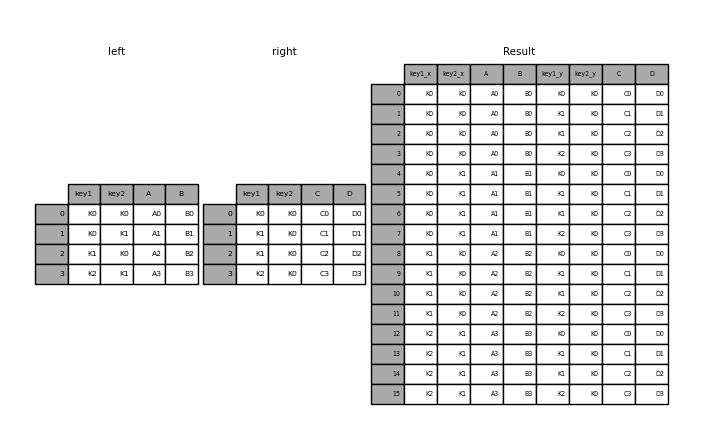
You can Series and a DataFrame with a MultiIndex if the names of
the MultiIndex correspond to the columns from the DataFrame. Transform
the Series to a DataFrame using Series.reset_index() before merging
In [60]: df = pd.DataFrame({"Let": ["A", "B", "C"], "Num": [1, 2, 3]})
In [61]: df
Out[61]:
Let Num
0 A 1
1 B 2
2 C 3
In [62]: ser = pd.Series(
....: ["a", "b", "c", "d", "e", "f"],
....: index=pd.MultiIndex.from_arrays(
....: [["A", "B", "C"] * 2, [1, 2, 3, 4, 5, 6]], names=["Let", "Num"]
....: ),
....: )
....:
In [63]: ser
Out[63]:
Let Num
A 1 a
B 2 b
C 3 c
A 4 d
B 5 e
C 6 f
dtype: object
In [64]: pd.merge(df, ser.reset_index(), on=["Let", "Num"])
Out[64]:
Let Num 0
0 A 1 a
1 B 2 b
2 C 3 c
Performing an outer join with duplicate join keys in DataFrame
In [65]: left = pd.DataFrame({"A": [1, 2], "B": [2, 2]})
In [66]: right = pd.DataFrame({"A": [4, 5, 6], "B": [2, 2, 2]})
In [67]: result = pd.merge(left, right, on="B", how="outer")
In [68]: result
Out[68]:
A_x B A_y
0 1 2 4
1 1 2 5
2 1 2 6
3 2 2 4
4 2 2 5
5 2 2 6
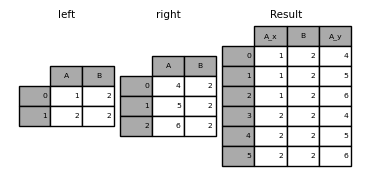
Warning
Merging on duplicate keys significantly increase the dimensions of the result and can cause a memory overflow.
Merge key uniqueness#
The validate argument checks whether the uniqueness of merge keys.
Key uniqueness is checked before merge operations and can protect against memory overflows
and unexpected key duplication.
In [69]: left = pd.DataFrame({"A": [1, 2], "B": [1, 2]})
In [70]: right = pd.DataFrame({"A": [4, 5, 6], "B": [2, 2, 2]})
In [71]: result = pd.merge(left, right, on="B", how="outer", validate="one_to_one")
---------------------------------------------------------------------------
MergeError Traceback (most recent call last)
Cell In[71], line 1
----> 1 result = pd.merge(left, right, on="B", how="outer", validate="one_to_one")
File ~/work/pandas/pandas/pandas/core/reshape/merge.py:170, in merge(left, right, how, on, left_on, right_on, left_index, right_index, sort, suffixes, copy, indicator, validate)
155 return _cross_merge(
156 left_df,
157 right_df,
(...)
167 copy=copy,
168 )
169 else:
--> 170 op = _MergeOperation(
171 left_df,
172 right_df,
173 how=how,
174 on=on,
175 left_on=left_on,
176 right_on=right_on,
177 left_index=left_index,
178 right_index=right_index,
179 sort=sort,
180 suffixes=suffixes,
181 indicator=indicator,
182 validate=validate,
183 )
184 return op.get_result(copy=copy)
File ~/work/pandas/pandas/pandas/core/reshape/merge.py:813, in _MergeOperation.__init__(self, left, right, how, on, left_on, right_on, left_index, right_index, sort, suffixes, indicator, validate)
809 # If argument passed to validate,
810 # check if columns specified as unique
811 # are in fact unique.
812 if validate is not None:
--> 813 self._validate_validate_kwd(validate)
File ~/work/pandas/pandas/pandas/core/reshape/merge.py:1657, in _MergeOperation._validate_validate_kwd(self, validate)
1653 raise MergeError(
1654 "Merge keys are not unique in left dataset; not a one-to-one merge"
1655 )
1656 if not right_unique:
-> 1657 raise MergeError(
1658 "Merge keys are not unique in right dataset; not a one-to-one merge"
1659 )
1661 elif validate in ["one_to_many", "1:m"]:
1662 if not left_unique:
MergeError: Merge keys are not unique in right dataset; not a one-to-one merge
If the user is aware of the duplicates in the right DataFrame but wants to
ensure there are no duplicates in the left DataFrame, one can use the
validate='one_to_many' argument instead, which will not raise an exception.
In [72]: pd.merge(left, right, on="B", how="outer", validate="one_to_many")
Out[72]:
A_x B A_y
0 1 1 NaN
1 2 2 4.0
2 2 2 5.0
3 2 2 6.0
Merge result indicator#
merge() accepts the argument indicator. If True, a
Categorical-type column called _merge will be added to the output object
that takes on values:
Observation Origin
_mergevalueMerge key only in
'left'frame
left_onlyMerge key only in
'right'frame
right_onlyMerge key in both frames
both
In [73]: df1 = pd.DataFrame({"col1": [0, 1], "col_left": ["a", "b"]})
In [74]: df2 = pd.DataFrame({"col1": [1, 2, 2], "col_right": [2, 2, 2]})
In [75]: pd.merge(df1, df2, on="col1", how="outer", indicator=True)
Out[75]:
col1 col_left col_right _merge
0 0 a NaN left_only
1 1 b 2.0 both
2 2 NaN 2.0 right_only
3 2 NaN 2.0 right_only
A string argument to indicator will use the value as the name for the indicator column.
In [76]: pd.merge(df1, df2, on="col1", how="outer", indicator="indicator_column")
Out[76]:
col1 col_left col_right indicator_column
0 0 a NaN left_only
1 1 b 2.0 both
2 2 NaN 2.0 right_only
3 2 NaN 2.0 right_only
Overlapping value columns#
The merge suffixes argument takes a tuple of list of strings to append to
overlapping column names in the input DataFrame to disambiguate the result
columns:
In [77]: left = pd.DataFrame({"k": ["K0", "K1", "K2"], "v": [1, 2, 3]})
In [78]: right = pd.DataFrame({"k": ["K0", "K0", "K3"], "v": [4, 5, 6]})
In [79]: result = pd.merge(left, right, on="k")
In [80]: result
Out[80]:
k v_x v_y
0 K0 1 4
1 K0 1 5

In [81]: result = pd.merge(left, right, on="k", suffixes=("_l", "_r"))
In [82]: result
Out[82]:
k v_l v_r
0 K0 1 4
1 K0 1 5

DataFrame.join()#
DataFrame.join() combines the columns of multiple,
potentially differently-indexed DataFrame into a single result
DataFrame.
In [83]: left = pd.DataFrame(
....: {"A": ["A0", "A1", "A2"], "B": ["B0", "B1", "B2"]}, index=["K0", "K1", "K2"]
....: )
....:
In [84]: right = pd.DataFrame(
....: {"C": ["C0", "C2", "C3"], "D": ["D0", "D2", "D3"]}, index=["K0", "K2", "K3"]
....: )
....:
In [85]: result = left.join(right)
In [86]: result
Out[86]:
A B C D
K0 A0 B0 C0 D0
K1 A1 B1 NaN NaN
K2 A2 B2 C2 D2

In [87]: result = left.join(right, how="outer")
In [88]: result
Out[88]:
A B C D
K0 A0 B0 C0 D0
K1 A1 B1 NaN NaN
K2 A2 B2 C2 D2
K3 NaN NaN C3 D3

In [89]: result = left.join(right, how="inner")
In [90]: result
Out[90]:
A B C D
K0 A0 B0 C0 D0
K2 A2 B2 C2 D2

DataFrame.join() takes an optional on argument which may be a column
or multiple column names that the passed DataFrame is to be
aligned.
In [91]: left = pd.DataFrame(
....: {
....: "A": ["A0", "A1", "A2", "A3"],
....: "B": ["B0", "B1", "B2", "B3"],
....: "key": ["K0", "K1", "K0", "K1"],
....: }
....: )
....:
In [92]: right = pd.DataFrame({"C": ["C0", "C1"], "D": ["D0", "D1"]}, index=["K0", "K1"])
In [93]: result = left.join(right, on="key")
In [94]: result
Out[94]:
A B key C D
0 A0 B0 K0 C0 D0
1 A1 B1 K1 C1 D1
2 A2 B2 K0 C0 D0
3 A3 B3 K1 C1 D1

In [95]: result = pd.merge(
....: left, right, left_on="key", right_index=True, how="left", sort=False
....: )
....:
In [96]: result
Out[96]:
A B key C D
0 A0 B0 K0 C0 D0
1 A1 B1 K1 C1 D1
2 A2 B2 K0 C0 D0
3 A3 B3 K1 C1 D1

To join on multiple keys, the passed DataFrame must have a MultiIndex:
In [97]: left = pd.DataFrame(
....: {
....: "A": ["A0", "A1", "A2", "A3"],
....: "B": ["B0", "B1", "B2", "B3"],
....: "key1": ["K0", "K0", "K1", "K2"],
....: "key2": ["K0", "K1", "K0", "K1"],
....: }
....: )
....:
In [98]: index = pd.MultiIndex.from_tuples(
....: [("K0", "K0"), ("K1", "K0"), ("K2", "K0"), ("K2", "K1")]
....: )
....:
In [99]: right = pd.DataFrame(
....: {"C": ["C0", "C1", "C2", "C3"], "D": ["D0", "D1", "D2", "D3"]}, index=index
....: )
....:
In [100]: result = left.join(right, on=["key1", "key2"])
In [101]: result
Out[101]:
A B key1 key2 C D
0 A0 B0 K0 K0 C0 D0
1 A1 B1 K0 K1 NaN NaN
2 A2 B2 K1 K0 C1 D1
3 A3 B3 K2 K1 C3 D3

The default for DataFrame.join is to perform a left join
which uses only the keys found in the
calling DataFrame. Other join types can be specified with how.
In [102]: result = left.join(right, on=["key1", "key2"], how="inner")
In [103]: result
Out[103]:
A B key1 key2 C D
0 A0 B0 K0 K0 C0 D0
2 A2 B2 K1 K0 C1 D1
3 A3 B3 K2 K1 C3 D3

Joining a single Index to a MultiIndex#
You can join a DataFrame with a Index to a DataFrame with a MultiIndex on a level.
The name of the Index with match the level name of the MultiIndex.
In [104]: left = pd.DataFrame(
.....: {"A": ["A0", "A1", "A2"], "B": ["B0", "B1", "B2"]},
.....: index=pd.Index(["K0", "K1", "K2"], name="key"),
.....: )
.....:
In [105]: index = pd.MultiIndex.from_tuples(
.....: [("K0", "Y0"), ("K1", "Y1"), ("K2", "Y2"), ("K2", "Y3")],
.....: names=["key", "Y"],
.....: )
.....:
In [106]: right = pd.DataFrame(
.....: {"C": ["C0", "C1", "C2", "C3"], "D": ["D0", "D1", "D2", "D3"]},
.....: index=index,
.....: )
.....:
In [107]: result = left.join(right, how="inner")
In [108]: result
Out[108]:
A B C D
key Y
K0 Y0 A0 B0 C0 D0
K1 Y1 A1 B1 C1 D1
K2 Y2 A2 B2 C2 D2
Y3 A2 B2 C3 D3

Joining with two MultiIndex#
The MultiIndex of the input argument must be completely used
in the join and is a subset of the indices in the left argument.
In [109]: leftindex = pd.MultiIndex.from_product(
.....: [list("abc"), list("xy"), [1, 2]], names=["abc", "xy", "num"]
.....: )
.....:
In [110]: left = pd.DataFrame({"v1": range(12)}, index=leftindex)
In [111]: left
Out[111]:
v1
abc xy num
a x 1 0
2 1
y 1 2
2 3
b x 1 4
2 5
y 1 6
2 7
c x 1 8
2 9
y 1 10
2 11
In [112]: rightindex = pd.MultiIndex.from_product(
.....: [list("abc"), list("xy")], names=["abc", "xy"]
.....: )
.....:
In [113]: right = pd.DataFrame({"v2": [100 * i for i in range(1, 7)]}, index=rightindex)
In [114]: right
Out[114]:
v2
abc xy
a x 100
y 200
b x 300
y 400
c x 500
y 600
In [115]: left.join(right, on=["abc", "xy"], how="inner")
Out[115]:
v1 v2
abc xy num
a x 1 0 100
2 1 100
y 1 2 200
2 3 200
b x 1 4 300
2 5 300
y 1 6 400
2 7 400
c x 1 8 500
2 9 500
y 1 10 600
2 11 600
In [116]: leftindex = pd.MultiIndex.from_tuples(
.....: [("K0", "X0"), ("K0", "X1"), ("K1", "X2")], names=["key", "X"]
.....: )
.....:
In [117]: left = pd.DataFrame(
.....: {"A": ["A0", "A1", "A2"], "B": ["B0", "B1", "B2"]}, index=leftindex
.....: )
.....:
In [118]: rightindex = pd.MultiIndex.from_tuples(
.....: [("K0", "Y0"), ("K1", "Y1"), ("K2", "Y2"), ("K2", "Y3")], names=["key", "Y"]
.....: )
.....:
In [119]: right = pd.DataFrame(
.....: {"C": ["C0", "C1", "C2", "C3"], "D": ["D0", "D1", "D2", "D3"]}, index=rightindex
.....: )
.....:
In [120]: result = pd.merge(
.....: left.reset_index(), right.reset_index(), on=["key"], how="inner"
.....: ).set_index(["key", "X", "Y"])
.....:
In [121]: result
Out[121]:
A B C D
key X Y
K0 X0 Y0 A0 B0 C0 D0
X1 Y0 A1 B1 C0 D0
K1 X2 Y1 A2 B2 C1 D1

Merging on a combination of columns and index levels#
Strings passed as the on, left_on, and right_on parameters
may refer to either column names or index level names. This enables merging
DataFrame instances on a combination of index levels and columns without
resetting indexes.
In [122]: left_index = pd.Index(["K0", "K0", "K1", "K2"], name="key1")
In [123]: left = pd.DataFrame(
.....: {
.....: "A": ["A0", "A1", "A2", "A3"],
.....: "B": ["B0", "B1", "B2", "B3"],
.....: "key2": ["K0", "K1", "K0", "K1"],
.....: },
.....: index=left_index,
.....: )
.....:
In [124]: right_index = pd.Index(["K0", "K1", "K2", "K2"], name="key1")
In [125]: right = pd.DataFrame(
.....: {
.....: "C": ["C0", "C1", "C2", "C3"],
.....: "D": ["D0", "D1", "D2", "D3"],
.....: "key2": ["K0", "K0", "K0", "K1"],
.....: },
.....: index=right_index,
.....: )
.....:
In [126]: result = left.merge(right, on=["key1", "key2"])
In [127]: result
Out[127]:
A B key2 C D
key1
K0 A0 B0 K0 C0 D0
K1 A2 B2 K0 C1 D1
K2 A3 B3 K1 C3 D3

Note
When DataFrame are joined on a string that matches an index level in both
arguments, the index level is preserved as an index level in the resulting
DataFrame.
Note
When DataFrame are joined using only some of the levels of a MultiIndex,
the extra levels will be dropped from the resulting join. To
preserve those levels, use DataFrame.reset_index() on those level
names to move those levels to columns prior to the join.
Joining multiple DataFrame#
A list or tuple of :class:`DataFrame` can also be passed to join()
to join them together on their indexes.
In [128]: right2 = pd.DataFrame({"v": [7, 8, 9]}, index=["K1", "K1", "K2"])
In [129]: result = left.join([right, right2])

DataFrame.combine_first()#
DataFrame.combine_first() update missing values from one DataFrame
with the non-missing values in another DataFrame in the corresponding
location.
In [130]: df1 = pd.DataFrame(
.....: [[np.nan, 3.0, 5.0], [-4.6, np.nan, np.nan], [np.nan, 7.0, np.nan]]
.....: )
.....:
In [131]: df2 = pd.DataFrame([[-42.6, np.nan, -8.2], [-5.0, 1.6, 4]], index=[1, 2])
In [132]: result = df1.combine_first(df2)
In [133]: result
Out[133]:
0 1 2
0 NaN 3.0 5.0
1 -4.6 NaN -8.2
2 -5.0 7.0 4.0

merge_ordered()#
merge_ordered() combines order data such as numeric or time series data
with optional filling of missing data with fill_method.
In [134]: left = pd.DataFrame(
.....: {"k": ["K0", "K1", "K1", "K2"], "lv": [1, 2, 3, 4], "s": ["a", "b", "c", "d"]}
.....: )
.....:
In [135]: right = pd.DataFrame({"k": ["K1", "K2", "K4"], "rv": [1, 2, 3]})
In [136]: pd.merge_ordered(left, right, fill_method="ffill", left_by="s")
Out[136]:
k lv s rv
0 K0 1.0 a NaN
1 K1 1.0 a 1.0
2 K2 1.0 a 2.0
3 K4 1.0 a 3.0
4 K1 2.0 b 1.0
5 K2 2.0 b 2.0
6 K4 2.0 b 3.0
7 K1 3.0 c 1.0
8 K2 3.0 c 2.0
9 K4 3.0 c 3.0
10 K1 NaN d 1.0
11 K2 4.0 d 2.0
12 K4 4.0 d 3.0
merge_asof()#
merge_asof() is similar to an ordered left-join except that mactches are on the
nearest key rather than equal keys. For each row in the left DataFrame,
the last row in the right DataFrame are selected where the on key is less
than the left’s key. Both DataFrame must be sorted by the key.
Optionally an merge_asof() can perform a group-wise merge by matching the
by key in addition to the nearest match on the on key.
In [137]: trades = pd.DataFrame(
.....: {
.....: "time": pd.to_datetime(
.....: [
.....: "20160525 13:30:00.023",
.....: "20160525 13:30:00.038",
.....: "20160525 13:30:00.048",
.....: "20160525 13:30:00.048",
.....: "20160525 13:30:00.048",
.....: ]
.....: ),
.....: "ticker": ["MSFT", "MSFT", "GOOG", "GOOG", "AAPL"],
.....: "price": [51.95, 51.95, 720.77, 720.92, 98.00],
.....: "quantity": [75, 155, 100, 100, 100],
.....: },
.....: columns=["time", "ticker", "price", "quantity"],
.....: )
.....:
In [138]: quotes = pd.DataFrame(
.....: {
.....: "time": pd.to_datetime(
.....: [
.....: "20160525 13:30:00.023",
.....: "20160525 13:30:00.023",
.....: "20160525 13:30:00.030",
.....: "20160525 13:30:00.041",
.....: "20160525 13:30:00.048",
.....: "20160525 13:30:00.049",
.....: "20160525 13:30:00.072",
.....: "20160525 13:30:00.075",
.....: ]
.....: ),
.....: "ticker": ["GOOG", "MSFT", "MSFT", "MSFT", "GOOG", "AAPL", "GOOG", "MSFT"],
.....: "bid": [720.50, 51.95, 51.97, 51.99, 720.50, 97.99, 720.50, 52.01],
.....: "ask": [720.93, 51.96, 51.98, 52.00, 720.93, 98.01, 720.88, 52.03],
.....: },
.....: columns=["time", "ticker", "bid", "ask"],
.....: )
.....:
In [139]: trades
Out[139]:
time ticker price quantity
0 2016-05-25 13:30:00.023 MSFT 51.95 75
1 2016-05-25 13:30:00.038 MSFT 51.95 155
2 2016-05-25 13:30:00.048 GOOG 720.77 100
3 2016-05-25 13:30:00.048 GOOG 720.92 100
4 2016-05-25 13:30:00.048 AAPL 98.00 100
In [140]: quotes
Out[140]:
time ticker bid ask
0 2016-05-25 13:30:00.023 GOOG 720.50 720.93
1 2016-05-25 13:30:00.023 MSFT 51.95 51.96
2 2016-05-25 13:30:00.030 MSFT 51.97 51.98
3 2016-05-25 13:30:00.041 MSFT 51.99 52.00
4 2016-05-25 13:30:00.048 GOOG 720.50 720.93
5 2016-05-25 13:30:00.049 AAPL 97.99 98.01
6 2016-05-25 13:30:00.072 GOOG 720.50 720.88
7 2016-05-25 13:30:00.075 MSFT 52.01 52.03
In [141]: pd.merge_asof(trades, quotes, on="time", by="ticker")
Out[141]:
time ticker price quantity bid ask
0 2016-05-25 13:30:00.023 MSFT 51.95 75 51.95 51.96
1 2016-05-25 13:30:00.038 MSFT 51.95 155 51.97 51.98
2 2016-05-25 13:30:00.048 GOOG 720.77 100 720.50 720.93
3 2016-05-25 13:30:00.048 GOOG 720.92 100 720.50 720.93
4 2016-05-25 13:30:00.048 AAPL 98.00 100 NaN NaN
merge_asof() within 2ms between the quote time and the trade time.
In [142]: pd.merge_asof(trades, quotes, on="time", by="ticker", tolerance=pd.Timedelta("2ms"))
Out[142]:
time ticker price quantity bid ask
0 2016-05-25 13:30:00.023 MSFT 51.95 75 51.95 51.96
1 2016-05-25 13:30:00.038 MSFT 51.95 155 NaN NaN
2 2016-05-25 13:30:00.048 GOOG 720.77 100 720.50 720.93
3 2016-05-25 13:30:00.048 GOOG 720.92 100 720.50 720.93
4 2016-05-25 13:30:00.048 AAPL 98.00 100 NaN NaN
merge_asof() within 10ms between the quote time and the trade time and
exclude exact matches on time. Note that though we exclude the exact matches
(of the quotes), prior quotes do propagate to that point in time.
In [143]: pd.merge_asof(
.....: trades,
.....: quotes,
.....: on="time",
.....: by="ticker",
.....: tolerance=pd.Timedelta("10ms"),
.....: allow_exact_matches=False,
.....: )
.....:
Out[143]:
time ticker price quantity bid ask
0 2016-05-25 13:30:00.023 MSFT 51.95 75 NaN NaN
1 2016-05-25 13:30:00.038 MSFT 51.95 155 51.97 51.98
2 2016-05-25 13:30:00.048 GOOG 720.77 100 NaN NaN
3 2016-05-25 13:30:00.048 GOOG 720.92 100 NaN NaN
4 2016-05-25 13:30:00.048 AAPL 98.00 100 NaN NaN
compare()#
The Series.compare() and DataFrame.compare() methods allow you to
compare two DataFrame or Series, respectively, and summarize their differences.
In [144]: df = pd.DataFrame(
.....: {
.....: "col1": ["a", "a", "b", "b", "a"],
.....: "col2": [1.0, 2.0, 3.0, np.nan, 5.0],
.....: "col3": [1.0, 2.0, 3.0, 4.0, 5.0],
.....: },
.....: columns=["col1", "col2", "col3"],
.....: )
.....:
In [145]: df
Out[145]:
col1 col2 col3
0 a 1.0 1.0
1 a 2.0 2.0
2 b 3.0 3.0
3 b NaN 4.0
4 a 5.0 5.0
In [146]: df2 = df.copy()
In [147]: df2.loc[0, "col1"] = "c"
In [148]: df2.loc[2, "col3"] = 4.0
In [149]: df2
Out[149]:
col1 col2 col3
0 c 1.0 1.0
1 a 2.0 2.0
2 b 3.0 4.0
3 b NaN 4.0
4 a 5.0 5.0
In [150]: df.compare(df2)
Out[150]:
col1 col3
self other self other
0 a c NaN NaN
2 NaN NaN 3.0 4.0
By default, if two corresponding values are equal, they will be shown as NaN.
Furthermore, if all values in an entire row / column, the row / column will be
omitted from the result. The remaining differences will be aligned on columns.
Stack the differences on rows.
In [151]: df.compare(df2, align_axis=0)
Out[151]:
col1 col3
0 self a NaN
other c NaN
2 self NaN 3.0
other NaN 4.0
Keep all original rows and columns with keep_shape=True
In [152]: df.compare(df2, keep_shape=True)
Out[152]:
col1 col2 col3
self other self other self other
0 a c NaN NaN NaN NaN
1 NaN NaN NaN NaN NaN NaN
2 NaN NaN NaN NaN 3.0 4.0
3 NaN NaN NaN NaN NaN NaN
4 NaN NaN NaN NaN NaN NaN
Keep all the original values even if they are equal.
In [153]: df.compare(df2, keep_shape=True, keep_equal=True)
Out[153]:
col1 col2 col3
self other self other self other
0 a c 1.0 1.0 1.0 1.0
1 a a 2.0 2.0 2.0 2.0
2 b b 3.0 3.0 3.0 4.0
3 b b NaN NaN 4.0 4.0
4 a a 5.0 5.0 5.0 5.0